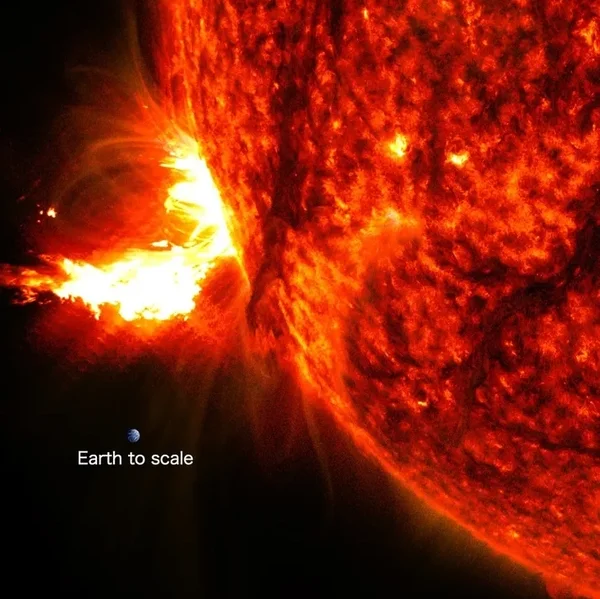Superstorm-Spawning Sunspot Cluster Is Facing Earth Again. What’s Next?
The massive sunspot region that gave Earthlings stunning auroral displays earlier in May is back from its trip around the far side of the sun

NASA’s Solar Dynamics Observatory captured this image of a solar flare seen as the bright flash on the limb of the Sun on May 27, 2024, with an inset image of Earth for scale. The image shows a subset of extreme ultraviolet light that highlights the extremely hot material in flares and which is colorized in red.
Earth may have a couple of stormy space weather weeks in store now that the massive sunspot cluster that sparked stunning auroral shows earlier this month has rotated back within sight of our planet. Even before it did so, the sunspot cluster unleashed a sizable solar flare that arced into view beyond the edge of the sun on May 27, and scientists are now eagerly watching to see what happens next.
“It seems this active region didn’t decay much,” says Kiran Jain, a heliophysicist at the National Solar Observatory. “It happens with active regions: they will decay a little bit, and then they will pick up strength again.”
The gigantic sunspot cluster gained fame as active region 3664 (AR3664), although after its passage around the sun, it has earned a new number: AR3697. In early and mid-May the original AR3664 merged with a second active region and let off a shocking barrage of activity from the ensuing gnarl of solar magnetic fields. “This merger created a bigger cluster,” says Madhulika Guhathakurta, a heliophysicist at NASA. “And when that happens, you absolutely know that this is going to produce flares. The more complex the region is, the more intense the flaring will be.”
On supporting science journalism
If you’re enjoying this article, consider supporting our award-winning journalism by subscribing. By purchasing a subscription you are helping to ensure the future of impactful stories about the discoveries and ideas shaping our world today.
Scientists categorize the radiation outbursts dubbed solar flares into five classes, of which X-class flares are the most powerful, just above M-class flares. All told, in the first half of May AR3664 produced 65 outbursts categorized as M- and X-class flares, the fourth highest tally for any active region since 1976. The cluster’s flares alone would make it very notable, both scientists say. “Successive X-class flares are not very common,” Jain says. “There’s something unusual with this active region.”
But that wasn’t all: AR3664 also spit out several titanic blobs of the sun’s charged plasma in events known as coronal mass ejections, or CMEs. The onslaught of flares and CMEs triggered a geomagnetic storm powerful enough to bring auroras—which are typically restricted to the Arctic and Antarctic Circles—as close to the equator as Puerto Rico and India.
Even as AR3664 put on a dazzling show, however, the sun’s rotation was fast carrying the active region to the edge of the disk we see from Earth. Because the sun isn’t solid, its rotational speed varies with latitude, with a complete loop taking more than a week longer at the poles than at the equator. But on average, scientists say that the sun rotates about once every 27 days.
So it wasn’t a particular mystery as to when the massive sunspot cluster would return, assuming it would survive its passage across the sun’s far side. Scientists could do more than just wait, however: they could track AR3664’s progress thanks to a stunning technique called helioseismology. Similar to how seismic waves can be used to map Earth’s hidden internal structure, sound waves rippling through the sun change their speed around the knotted magnetic fields of sunspots, giving scientists a way to reveal active regions on the solar far side.
Jain, who specializes in helioseismology, tracked AR3664 along its far side journey and knew the massive feature would survive the track. And even before the sunspot cluster, now dubbed AR3697, made its entrance, it released a sizable X2.8-class flare a bit after 3 A.M. EDT on May 27. After it spun into view, it also produced an X1.4 flare on the morning of May 29.
That said, we shouldn’t necessarily anticipate the same level of outbursts from the massive cluster as during AR3664’s initial transit. “I think we may get some more flares, but I’m not expecting to get as much activity as we had three weeks ago,” Jain says. “With time, active regions lose their strength, and they are not as active as they were in the previous rotation.” Still, the region won’t necessarily dissolve soon, she says: some particularly gargantuan sunspot clusters have lasted for up to four rotations.
Scientists are also working to understand how AR3664/AR3697 fits into the broader picture of the sun’s current activity cycle, dubbed Solar Cycle 25. The sun creates its own magnetic field, which flips over the course of about 11 years, and right now, it is at a tricky point in its activity cycle—either still heating up or at its peak.
This is a time when scientists expect to see a lot of activity. “During the rising phase of the solar cycle, it’s like fireworks on the Fourth of July,” Guhathakurta says. “Literally things are popping all over.” All the noisy fluctuations mean the solar cycle’s precise progression can’t be evaluated in the moment—its maximum (and minimum) can only be confirmed in hindsight by analyzing about six months of data.
Either way, more solar fireworks are in the forecast, but whether we might see a historic spectacle like that of this spring is anyone’s guess. “We never know that we have reached the peak of activity until we have seen it going down,” Guhathakurta says. “Are we close to reaching the peak, or is it going to keep rising? We don’t know.”
